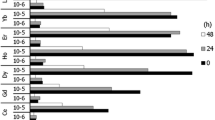Abstract
Cell cycle mechanisms are highly conserved from unicellular eukaryotes to complex metazoans including humans. Abnormalities in the regulation of the cell cycle result in death or diseases such as cancer. Early development of sea urchin has proved to be a powerful model for cell division studies and offers the opportunity to study synchronous cell divisions in the absence of transcriptional control. We have analyzed pesticide-induced dysfunctions in the first cell division following fertilization in sea urchin embryos, using Roundup, a widely used pesticide formulation containing isopropylamine glyphosate as the active substance. The pesticide induced cell cycle dysfunction by preventing the in vivo activation of the universal cell cycle regulator CDK1/cyclin B. We further show that synthesis of the regulator protein, cyclin B, as well as its association to the catalytic protein, CDK1, were not affected by the pesticide. Therefore, our results suggest that the pollutant impedes the processing of the CDK1/cyclin B complex, which is required in its physiological activation. Our studies demonstrate the relevance of sea urchin embryonic cells as a sensitive model to assess pesticide toxicity at the level of the universal cell cycle checkpoints.




Similar content being viewed by others
References
Arion D, Meijer L (1989) M-phase-specific protein kinase from mitotic sea urchin eggs: cyclic activation depends on protein synthesis and phosphorylation but does not require DNA or RNA synthesis. Exp Cell Res 183:361–375
Barr DB, Barr JR, Driskell WJ, Hill RH Jr, Ashley DL, Needham LL, Head SL, Sampson EJ (1999) Strategies for biological monitoring of exposure for contemporary-use pesticides. Toxicol Ind Health 15:168–179
Blair A, Zahm SH (1990) Herbicides and cancer: a review and discussion of methodologic issues. Recent Results Cancer Res 120:132–145
Borgne A, Meijer L (1996) Sequential dephosphorylation of p34(cdc2) on Thr-14 and Tyr-15 at the prophase/metaphase transition. J Biol Chem 271:27847–27854
Borgne A, Ostvold AC, Flament S, Meijer L (1999) Intra-M phase-promoting factor phosphorylation of cyclin B at the prophase/metaphase transition. J Biol Chem 274:11977–11986
Cohen-Fix O, Koshland D (1997) The metaphase-to-anaphase transition: avoiding a mid-life crisis. Curr Opin Cell Biol 9:800–806
Dube F (1988) Effect of reduced protein synthesis on the cell cycle in sea urchin embryos. J Cell Physiol 137:545–552
Dunphy WG, Brizuela L, Beach D, Newport J (1988) The Xenopus cdc2 protein is a component of MPF, a cytoplasmic regulator of mitosis. Cell 54:423–431
Epel D (1990) The initiation of development at fertilization. Cell Differ Dev 29:1–12
Hartwell LH, Weinert TA (1989) Checkpoints: controls that ensure the order of cell cycle events. Science 246:629–634
Laemmli UK (1970) Cleavage of structural proteins during the assembly of the head of bacteriophage T4. Nature 227:680–685
Lozano JC, Schatt P, Marques F, Peaucellier G, Fort P, Feral JP, Geneviere AM, Picard A (1998) A presumptive developmental role for a sea urchin cyclin B splice variant. J Cell Biol 140:283–293
Malik J, Barry G, Kishore G (1989) The herbicide glyphosate. Biofactors 2:17–25
Marc J, Mulner-Lorillon O, Boulben S, Hureau D, Durand G, Belle R (2002) Pesticide Roundup provokes cell division dysfunction at the level of CDK1/cyclin B activation. Chem Res Toxicol 15:326–331
Molinari M (2000) Cell cycle checkpoints and their inactivation in human cancer. Cell Proliferation 33:261–274
Nigg, EA (2001) Cell division mitotic kinases as regulators of cell division and its checkpoints. Nat Rev Mol Cell Biol 2:21–32
Nurse P (2000) A long twentieth century of the cell cycle and beyond. Cell 100:71–78
O'Farrel PH (2001) Triggering the all-or-nothing switch into mitosis. Trends Cell Biol 11:512–519
Sever LE, Arbuckle TE, Sweeney A (1997) Reproductive and developmental effects of occupational pesticide exposure: the epidemiologic evidence. Occup Med 12:305–325
Thomas RS, Rank DR, Penn SG, Zastrow GM, Hayes KR, Pande K, Glover E, Silander T, Craven MW, Reddy JK, Jovanovich SB, Bradfield CA (2001) Identification of toxicologically predictive gene sets using cDNA microarrays. Mol Pharmacol 60:1189–1194
Towbin H, Staehelin T, Gordon J (1979) Electrophoretic transfer of proteins from polyacrylamide gels to nitrocellulose sheets: procedure and some applications. Proc Natl Acad Sci USA 76:4350–4354
Williams GM, Kroes R, Munro IC (2000) Safety evaluation and risk assessment of the herbicide Roundup and its active ingredient, glyphosate, for humans. Regul Toxicol Pharmacol 31:117–165
Yamada K (1998) Dependence of timing of mitotic events on the rate of protein synthesis and DNA replication in sea urchin early cleavages. Cell Proliferation 31:203–215
Acknowledgements
We are very grateful to Sandrine Boulben and Cecile Maguer for their expert technical assistance. This work was supported by Conseil Régional de Bretagne, Les Fonds Européens de Développement Régional (FEDER), Association de la Recherche contre le Cancer (ARC) and Ligue Nationale contre le Cancer.
Author information
Authors and Affiliations
Corresponding author
Additional information
R. Belle can also be reached at http://www.sb-roscoff.fr.
Rights and permissions
About this article
Cite this article
Marc, J., Mulner-Lorillon, O., Durand, G. et al. Embryonic cell cycle for risk assessment of pesticides at the molecular level. Environ Chem Lett 1, 8–12 (2003). https://doi.org/10.1007/s10311-002-0015-2
Accepted:
Published:
Issue Date:
DOI: https://doi.org/10.1007/s10311-002-0015-2




